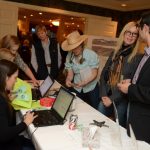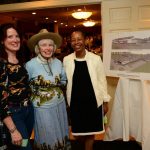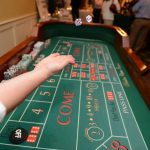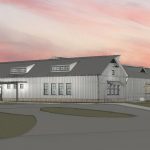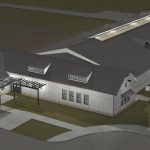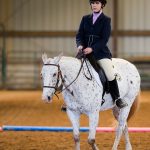Northern Virginia Therapeutic Riding Program (NVTRP) held their annual Cowboy Casino Night fundraiser on Saturday April 27th. Daniel Blair, the Project Architect for the project, and his wife attended the event. It was a fun-filled evening for all who turned out to show their support for this fantastic non-profit organization. I’ll let Dan tell the rest of the story from here…
It has been a great experience assisting the NVTRP with their vision for a new therapeutic riding facility. The design includes a 85’ x 200’ indoor arena, a state of the art therapy center, administrative area, and future 24-stall stable. Up until that evening, I had only met and worked with the leaders of the organization. One of the highlights of the event was meeting one of the NVTRP’s riders, Blythe, who will benefit from our design. Her story is not only inspiring, but I think she is also a symbol of the hope and perseverance that can be found at many of these non-profits.
My wife, Ellie, and I are very active volunteers in animal rescue; volunteering for both the Washington Humane Society and HART in Virginia. From our experience, I am quite familiar with the difficulties that non-profits face when trying to make progress; whether it be political resistance to closing puppy mills or dealing with limited resources from a slow economy.
The goal of most non-profits is to eventually put themselves out of business; whether it is fighting breast cancer or getting control of the pet population, the non-profit is there to serve as a stop-gap until the larger issue is resolved. However, therapeutic riding is unique. They are not a stopgap but provide highly specialized therapy to improve the lives of people who face potentially life long physical and mental disabilities.
Therapeutic riding programs fulfill a human need and are often an under-appreciated service. Typically, there is very little funding available as other charitable programs are often given higher priority and there is no guarantee that insurance will cover the sessions. Additionally, the operation of the facility is very expensive. Not only do they have administrative and specialized care costs, but they also have to house, feed, and care for the horses. Volunteers are typically difficult to find since some positions require previous equestrian experience and horse handling skills. Unfortunately, there is a very limited pool of volunteers for therapeutic riding and many programs struggle to find assistance.
Blythe has been involved with NVTRP for the past fourteen years. She began at the NVTRP with one simple goal in mind: learn how to ride a horse to assist in dealing with her disability.
When Blythe was three she acquired herpesviral encephalitis that caused her to enter into a coma. When she awoke, her life was completely changed. Blythe was left totally blind and had permanent brain damage. Over time, she has regained only the central portion of her vision. As a result, she is unable to see peripherally and always has to turn her head to understand her surroundings. To make things even more difficult, the brain damage produced spatial challenges for her. You and I take the spatial capability of our brain for granted, but for Blythe, understanding the difference between right and left, straight, or up and down is very challenging.
Through the use of therapeutic horseback riding and the program’s help, Blythe has been able to face and overcome many of her challenges. When she first began at the NVTRP, Blythe required a side walker and leader to help her through the ring. After a lot of practice and hard work, she progressed to only requiring a leader. Now, as she has learned how to canter and a leader can no longer keep up with her pace, she rides independently. She still always has someone in the ring giving directions; letting her know when to turn left, right, straight, and how much.
According to Blythe, growing up at NVTRP has been a life-changing experience. The bond that develops between any rider and horse is amazing. When it exists, the horse truly wants to work with the rider because of the relationship between them. Blythe has had the opportunity to bond with several horses at NVTRP and some have been there even longer than she has, such as Chet and Peaches. However, as Blythe says, “Chet will always hold that special place in my heart.” Due to the services and benefits she received at the program, Blythe decided to give back and became a volunteer. She now helps with fundraising and building awareness about NVTRP’s program.
For the casino night fundraiser, Blythe contacted her favorite author, Jeff Shaara, and told him about her involvement with NVTRP. She asked if he would donate to the NVTRP’s silent auction. He responded and offered to donate a signed copy of his new Civil War trilogy.
Here is my favorite part of the story. She thanked him profusely and casually mentioned that the Civil War trilogy was indeed great, but noted that her favorite of his works was his World War II trilogy. A copy of both trilogies, signed by the author, arrived in the mail shortly thereafter. Blythe’s persistence and determination captures the spirit of the NVTRP and other therapeutic riding organizations. The life-changing therapy she has received demonstrates the value that organizations like NVTRP provide our communities and people within them.
Though my wife and I may not have won the Civil War Trilogy box set that evening, we were able to have a lot of fun, support a good cause, and meet one of the beneficiaries of my work, which is one of the best experiences an architect can ever ask for.
The NVTRP is presently conducting its capital campaign for its new therapeutic facility. If you are interested in assisting, please see their Raise the Barn campaign at this link. If you are a fan of Jeff Shaara’s work, the World War II set will be up for auction at the NVTRP’s Ride to Thrive Polo Classic on September 21st; courtesy of Blythe of course.
